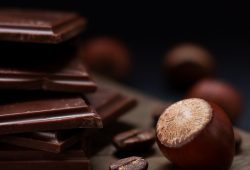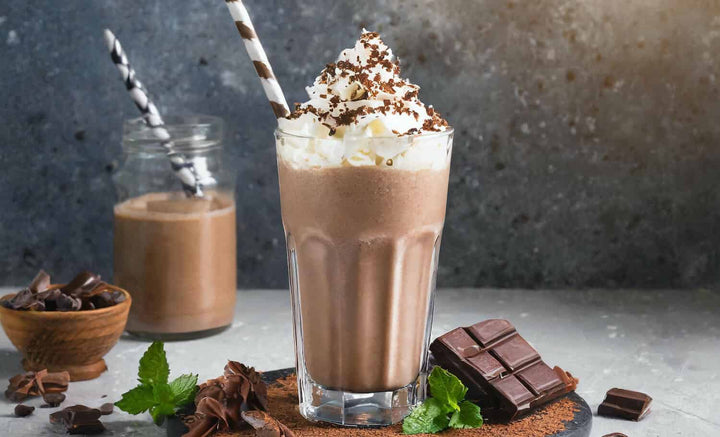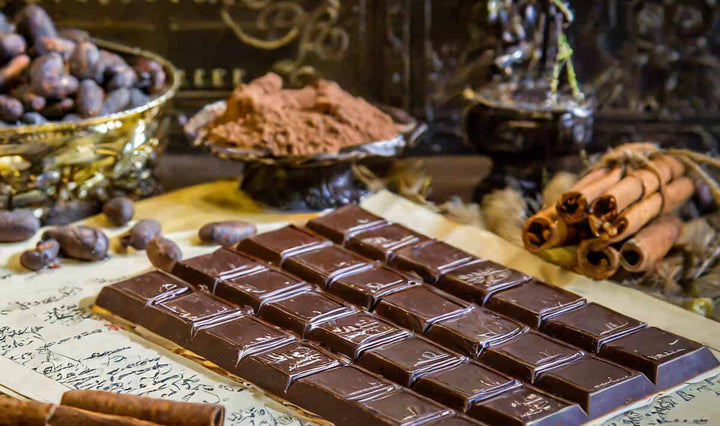In the ever-evolving world of confectionery, a new and exciting trend has emerged, captivating the taste buds of chocolate enthusiasts across the UK: Whole Fruit Chocolate.
This innovative approach to chocolate-making involves using the entire fruit – not just the cocoa beans – to create a uniquely flavourful and sustainable chocolate experience.
What is Whole Fruit Chocolate?
Whole Fruit Chocolate is an innovative and increasingly popular type of chocolate that is gaining attention for its unique approach to chocolate making.
Unlike traditional chocolate, primarily made from cocoa beans, Whole Fruit Chocolate utilises all of the cocoa fruit, including its pulp.
Only cocoa beans are used in standard chocolate production, while the surrounding fruit pulp is often discarded.
However, in Whole Fruit Chocolate, this pulp, which is naturally sweet and tangy, is incorporated into the chocolate-making process.
This reduces waste and adds a distinct flavour profile to the chocolate.
The result is a chocolate that has a more complex and nuanced taste, often with subtle fruity undertones, depending on the type of cocoa fruit used.
This method also reduces the added sugars typically required in traditional chocolate production, as the natural sweetness of the cocoa pulp contributes to the overall flavour.
Furthermore, Whole Fruit Chocolate aligns with a growing interest in sustainable and environmentally friendly practices in food production.
By utilising all of the cocoa fruit, producers can minimise waste and create a product that's both delicious and more considerate of the environment.
This approach to chocolate-making represents a shift towards more innovative and sustainable practices in the confectionery industry.
Related Post: What is Carob Syrup?
What Does Whole Fruit Chocolate Taste Like?
Whole Fruit Chocolate is distinguished by its subtle fruity undertones, derived from the cocoa pulp, which is often overlooked in traditional chocolate making.
This pulp adds natural sweetness and a slight tanginess, varying with the type of cocoa fruit.
Unlike traditional dark chocolate, Whole Fruit Chocolate tends to be less bitter, even with high cocoa content, due to the natural sweetness of the pulp.
Let's look at this in more detail:
-
Fruity Notes: The most notable aspect of Whole Fruit Chocolate is the subtle fruity undertones. The cocoa pulp, often overlooked in conventional chocolate making, provides natural sweetness and a slight tanginess, which can vary depending on the type of cocoa fruit used.
-
Reduced Bitterness: Since the pulp adds natural sweetness, Whole Fruit Chocolate tends to have a reduced bitterness compared to traditional dark chocolate, even when the cocoa content is high.
-
Complex Flavours: Combining cocoa beans and fruit pulp produces a more complex flavour. Depending on the specific cocoa fruit used, you might detect hints of berry, citrus, or tropical fruits alongside traditional chocolate's familiar rich and creamy notes.
-
Varied Texture: The texture can also differ. Some Whole Fruit Chocolates might have a smoother, creamier feel, while others might retain a slight fruit-derived texture.
-
Sweetness: Whole Fruit Chocolate is often less reliant on added sugars, thanks to the natural sweetness from the cocoa pulp. This results in a balanced sweetness that complements the cocoa rather than overpowering it.
Overall, Whole Fruit Chocolate provides a refreshing and innovative taste experience.

What’s the Difference Between Whole Fruit and Normal Chocolate?
The primary difference between whole fruit chocolate and regular (traditional) chocolate is the ingredients used and the overall environmental impact of their production.
Ingredients:
-
Whole Fruit Chocolate: This type of chocolate incorporates all the cocoa fruit in its production. Not only are the cocoa beans used, but also the surrounding fruit pulp, which is typically discarded in traditional chocolate making. The pulp adds natural sweetness and a distinct fruity flavour to the chocolate.
-
Regular Chocolate: Traditional chocolate is made primarily from cocoa beans, with added ingredients like sugar, milk (in milk chocolate), and sometimes additional flavours or emulsifiers. The cocoa fruit pulp is not used, focusing solely on the beans.
Flavour Profile:
-
Whole Fruit Chocolate: Offers a more complex and nuanced taste, often with subtle fruity undertones and a natural sweetness from the cocoa pulp. It tends to be less bitter than traditional dark chocolate.
-
Regular Chocolate: The flavour is primarily derived from the cocoa beans and added ingredients. It can range from sweet and creamy in milk chocolate to rich and bitter in dark chocolate.
Environmental Impact:
-
Whole Fruit Chocolate: By utilising all of the cocoa fruit, Whole Fruit Chocolate is more sustainable and environmentally friendly. This approach reduces waste and maximises the use of available resources.
-
Regular Chocolate: Traditional chocolate production can be more wasteful, as the cocoa pulp is typically discarded. This means only a fraction of the harvested cocoa fruit is used.
Sugar Content:
-
Whole Fruit Chocolate: Often requires less added sugar due to the natural sweetness of the cocoa pulp.
-
Regular Chocolate: The sweetness largely depends on the amount of added sugar and other sweetening agents.
Whole fruit chocolate is a more sustainable and environmentally conscious choice that offers a unique flavour experience compared to traditional chocolate.
It represents a shift towards innovative and responsible food production, appealing to environmentally conscious people looking for new taste experiences.
Related Post: Discover Natural Cocoa Powder
What Are the Ingredients in Whole Fruit Chocolate?
Whole Fruit Chocolate, an innovative approach in the confectionery world, includes unique ingredients that set it apart from traditional chocolate.
The critical ingredients of Whole Fruit Chocolate are:
-
Cocoa Beans: Like traditional chocolate, Whole Fruit Chocolate uses cocoa beans, which are the source of the chocolate's rich flavour and colour.
-
Cocoa pulp: This is what distinguishes whole fruit chocolate from regular chocolate. Instead of discarding the pulp that surrounds the cocoa beans, it is utilised in the chocolate-making process. The pulp, which is naturally sweet and tangy, adds a unique flavour and natural sweetness to the chocolate.
-
Sugar: While Whole Fruit Chocolate often requires less added sugar due to the natural sweetness from the cocoa pulp, some sugar may still be included to achieve the desired taste.
-
Milk Powder (in milk chocolate varieties): For milk chocolate versions of Whole Fruit Chocolate, milk powder is included to provide a creamy texture and flavour.
-
Additional Flavourings and Emulsifiers: Depending on the specific recipe and desired outcome, additional flavourings like vanilla or emulsifiers like soy lecithin may be added to enhance the taste and texture of the chocolate.
Using the entire cocoa fruit, including the pulp, imparts a distinct flavour profile to Whole Fruit Chocolate and contributes to its sustainability.
By utilising more parts of the cocoa fruit, this type of chocolate reduces waste and offers an environmentally friendlier option in the chocolate market.
Is Whole Fruit Healthier Than Normal Chocolate?
Whether Whole Fruit Chocolate is healthier than regular chocolate depends on various factors, including the specific ingredients used and the overall composition of the chocolate.
-
Sugar Content: One of the potential health benefits of Whole Fruit Chocolate is that it may contain less added sugar. The natural sweetness of the cocoa pulp can reduce the need for additional sweeteners, which is a positive aspect considering the health implications of high sugar consumption.
-
Antioxidants: Whole Fruit Chocolate and traditional chocolate (especially dark varieties) contain antioxidants found in cocoa beans, which are beneficial for health. However, including the cocoa pulp in Whole Fruit Chocolate could increase its antioxidant content.
-
Fibre Content: The use of all the cocoa fruit, including the pulp, in Whole Fruit Chocolate might result in a higher fibre content compared to traditional chocolate, where only the beans are used.
-
Caloric Density: The caloric content of Whole Fruit Chocolate can vary, but the use of the whole fruit and potentially less added sugar might result in a lower calorie count compared to some traditional chocolates, especially those with high sugar and fat content.
-
Sustainability and Environmental Impact: While not directly related to individual health, the sustainability aspect of Whole Fruit Chocolate is a health benefit on a broader environmental level. By using more parts of the cocoa fruit, this approach reduces waste and is more environmentally friendly.
It's important to remember that while Whole Fruit Chocolate can have these potential health advantages, it should still be consumed in moderation as part of a balanced diet.
The overall health impact also depends on the specific type of chocolate, whether dark, milk, or white, and other added ingredients.
As with any food product, checking the label for specific nutritional information is recommended.
Is Whole Fruit Chocolate More Eco-Friendly?
Whole Fruit Chocolate is considered more eco-friendly than traditional chocolate, primarily due to its more sustainable and waste-reducing production process.
The key factors contributing to its eco-friendliness include:
-
Utilisation of the Entire Cocoa Fruit: In traditional chocolate production, only the cocoa beans are used, and the surrounding fruit pulp is often discarded. On the other hand, Whole Fruit Chocolate uses both the beans and the pulp. This comprehensive use of the fruit significantly reduces waste and better uses the resources involved in cocoa farming.
-
Reduced Food Waste: The innovative approach of using the entire cocoa fruit aligns with global efforts to reduce food waste, a significant environmental concern. Whole Fruit Chocolate contributes to a more efficient and responsible food production system by valuing and utilising all parts of the cocoa fruit.
-
Potential for Lower Sugar Production: Since the natural sweetness of the cocoa pulp can reduce the need for additional sugar, Whole Fruit Chocolate might indirectly lessen the environmental impact associated with sugar production, which includes land use, water consumption, and pesticide use.
-
Contribution to Sustainable Farming Practices: The demand for Whole Fruit Chocolate can encourage and support sustainable farming practices. Providing a use for the entire cocoa fruit can potentially increase the income of cocoa farmers and promote more environmentally conscious farming methods.
While Whole Fruit Chocolate is a step towards more environmentally friendly confectionery, the overall environmental impact also depends on other factors, such as sourcing ingredients, manufacturing processes, and packaging.
Where Can You Buy Sumptuous Chocolate?
Whitakers Chocolates is renowned for its long history in crafting delicious and affordable chocolates.
It offers a range of options suitable for everyone, including vegetarian, vegan, and gluten-free choices.
Our top-selling products, such as indulgent Coffee Creams, Neapolitans, Chocolate Wafer Thins, and Luxury Chocolate Truffles, are the perfect accompaniments to enhance your mocha coffee experience.
Some Notes From an Expert Chocolatier
As an expert chocolatier, one of the most exhilarating aspects of my profession is the vast diversity and innovation within the industry, especially with the advent of products like Whole Fruit Chocolate.
Working with various ingredients with unique flavours and characteristics opens up endless possibilities for creativity and experimentation.
Introducing Whole Fruit Chocolate is particularly exciting; it's a new flavour or texture to explore and a new approach to sustainable chocolate making.
This shift towards using the entire cocoa fruit challenges us to think differently about our recipes and processes, allowing for innovation while contributing positively to environmental sustainability.
Final Notes On Whole Fruit Chocolate
Whole Fruit Chocolate represents a significant innovation in the confectionery world, marking a shift towards more sustainable and environmentally conscious chocolate production.
Utilising the entire cocoa fruit, including the often-discarded pulp, reduces waste and introduces a unique and nuanced flavour profile to the chocolate.
This approach provides a natural sweetness and a complex taste that differs from traditional chocolate.
It may also offer potential health benefits, such as reduced added sugar and higher antioxidant content.











